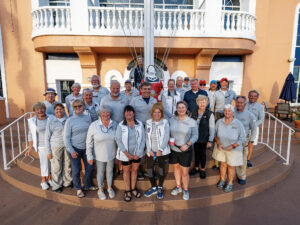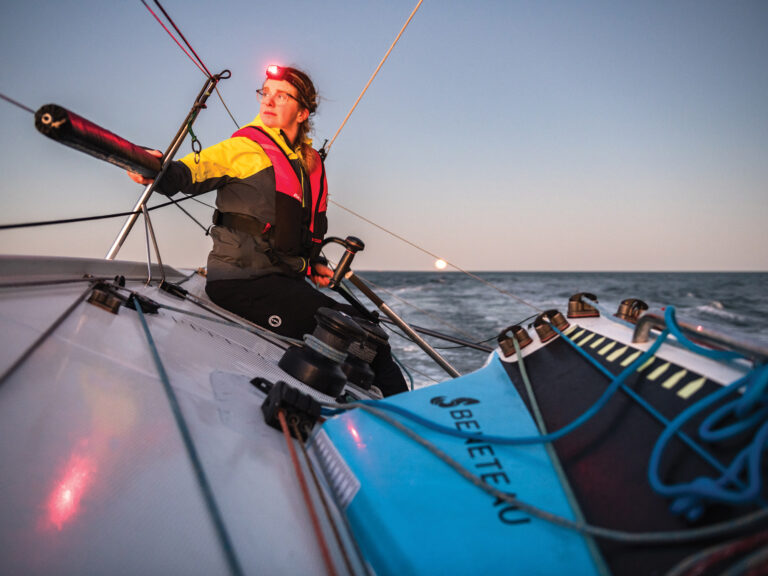The Helly Hansen NOOD Regatta in Chicago, being an early-season regatta, is sailed when Lake Michigan’s water temperature is still quite cool. If there is a warm spell, the land-to-water temperature difference can be a whopping 30, or even 40 degrees, so thermal effects will be a dominant factor in how conditions set up. This is particularly true when the pressure gradients are weak, as they usually are with our standard lake-breeze scenario.
If you’re new to Chicago sailing, one peculiarity to be aware of when the water is still cold is excessive wind shear. The colder layer near the water moves more slowly so there’s more breeze aloft, and the upper air is often more from the right, especially in easterly and southeasterly wind directions. The taller your rig, the more you need to be cognizant of this phenomenon, which will require slightly different approaches to trimming and steering from tack-to-tack. When you do your pre-race wind check, keeping the main boom on centerline, check to see if the windex points to the right. Starboard tack will be easier to maintain speed and height because the upper breeze is a wider angle. Port tack, on the other hand, can be frustrating as helmsmen must steer lower and pay special attention that the upper telltales aren’t luffing.
Southwesterly: In this prevailing summer breeze, you want to get toward the shore as soon as you can. You will get better pressure closer to shore (wind is lifted off the cold water further from shore, especially in the spring. If the racetrack allows proximity to shore, you will get right-handers on the right (off the shore). Downwind, you might jibe onto port early for pressure and header, and later in the leg (away from shore) you might get a starboard header.
Westerly: The wind is not likely to stay from this direction long. It’s usually a long-term right trend to the northwest, but this is a puffy and quick-shifting wind, even more so as you get closer to shore. Play the oscillations, “connect the dots” upwind, and look to stay in sustained streaks of pressure downwind.
Northwesterly: If the breeze is post-frontal, we can get some great heavy-air sailing in northwesterly winds. The wind should continue to shift to the North, but slowly, so as you would in the westerly, play the oscillations, which dominate. Boats nearer the shore may show signs of windshifts and residual blasts from the west, so late in the upwind leg left may pay off.
Northerly: When the breeze comes from North it means high pressure is building. The first day of this is big breeze and big waves for some excitement. Boathandling can be more important than shifts. As it matures, however, into the second or even third day, it will diminish and shift right.
Northeasterly: Usually, this is the dying phase of the northerly, which means you want to play the right trend, as it will eventually go all the way back around to the southwest, but also watch for the lefties when it starts to get pretty light.
Easterly:This is Chicago’s most fickle and unsettled wind. Don’t confuse it with a thermal. This is not a steady wind like the east-southeast thermal. All I can say is, ” good luck.”
Southeasterly: When this is not a thermal, we’re in the weather systems wet sector, meaning it’s overcast and humid with showers and a frontal passage on the way. Look for moderate strength with moderate shifts, until the front approaches and it builds.
Southerly: The straight southerly is an unusual direction, not likely to stay in place for long. It’s usually a result of a conflict between the southeasterly thermal and southwesterly land breeze. Keep an eye on boats to both edges of the course, and try to sail in whichever breeze will dominate.
Now let’s talk about the thermal, which will most likely develop on a warm day, not too cloudy, with south or southwest winds forecast. As you leave the harbor and the southerlies fade away from land, expect it. Classic meteorology says thermals start near shore, but not in Chicago. The Thermal is 2 to 3 miles or even more away. There is a Convergence Zone (aka the “bug zone”) between the southwest land breeze and southeast lake breeze. Avoid this zone all costs (hopefully the race committee boat is not in it, but often is).
The thermal fills in at approximately 120 degrees (in the 95- to 140-degree range). Direction will be remarkably steady and pressure will be better further offshore, especially early in the cycle as the thermal is developing. In this case, bang the left corner upwind, even if the race committee favors the boat end. We usually stay to the same side downwind (for best pressure). Later in the afternoon, the pressure may even out across the course, and the trend may be to the right. Often times, the thermal ends up about 150 degrees, so keep an open mind and your eyes out for the right side later in the day.
Enjoy our lake and our city, and welcome to Chicago from the team at North Sails Midwest.










